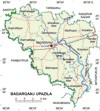 |
 |
 |
Photo Collection
Places
India
Bakergunj
On 23 June 1909, Sri Aurobindo delivered a speech here.
Maps
Photos
Bakergunj (Badarganj) is a municipal town at Rangpur District located at 25,6636° N and 89,052° E. Population: 1991-23219, 1996-26881, 2006-33280. The area of the town is 21.88 sq km. Literacy rate among the town people is 31.1%. The town is well known for rice and paddy trade. Archaeological heritage and relics Nine-domed Mosque at Lal Dighir Par of Radhanagar union, tomb of Kutub Shah at Kutubpur union, Bakhtyar Danga, Vhim Garh at Mansinghapur, Madai Khamar, Zamindar Bari at Dilalpur.Historical events Tradition goes that Badarganj is named after the mystic-saint Hazrat Badaruddin Shah (R). His tomb is located at the centre of the town. Having conquered Bengal, Turk Commander Ikhtyr Uddin Muhammad Bin Bakhtyr Khilji stopped over at Bakhtyr Danga during his invasion of Tibet in 1203 AD to fed his horses. Bakhtyr Danga is named after this.
Marks of the War of Liberation Mass killing site 2 (Jharuar Beel and Padmapukur).
Religious institutions Mosque 315, temple 32, church 6, sacred place 1.
Population 213431; male 51.28%, female 48.72%; Muslim 86.98%, Hindu 11.96% and others 1.06%; ethnic nationals: considerable number of Oraon and Santal population.
Literacy and educational institutions Average literacy 23.9%; male 31.1%, female 16.2%. Educational institutions: college 8, high school 33, madrasa 22, government primary school 82, non-government primary school 9.
Cultural organisations Library 1, cinema hall 2, theatre group 6, theatre stage 1, literary society 2, women's organisation 3.
Main occupations Agriculture 43.49%, agricultural labourer 32.42%, wage labourer 2.16%, commerce 10.02%, service 3.76%, others 8.15%.
Land use Total cultivable land 23238 hectares; fallow land 72 hectares, single crop 10.66%, double crop 60.09%, treble crop 29.25%; land under irrigation 60%.
Land control Among the peasants 30% are landless, 30% small, 25% intermediate, 15% rich.
Value of land The market value of the land of the first grade is approximately Tk 6200 per 0.01 hectare.
Main crops Paddy, jute, wheat, potato, onion, garlic, brinjal, patal.
Extinct or nearly extinct crops Linseed, sesame, tobacco, pulses, kaun.
Main fruits Mango, black berry, ata (custard-apple), jamrul, banana.
Fisheries, dairies and poultries Fishery 30, poultry 23, hatchery 5.
Communication facilities Roads: pucca 13 km, semi pucca 21 km and mud road 866 km; waterways: 16 nautical mile; Railways 16.6 km.
Traditional transport Palanquin, horse carriage, bullock cart. These means of transport are either extinct or nearly extinct.
Manufactories Sugar mill 1, distilleries 1, rice mill 139, ice cream factory 1, welding and steel works 15.
Cottage industries Badarganj is famous for the production of shataranchi (a kind of tapestry). Other cottage industries of the upazila include bamboo work 159, weaving 15, goldsmith 8, blacksmith 12, potteries 20, wood work 40, tailoring 30, bidi 70.
Hats, bazars and fairs Total number of hats and bazars are 16, most noted of which are Badarganj, Laldighi, Kutubpur, Bagmara, Faridpur, Bakshmiganj, Bagarganj, Mominpur hat; noted fairs are Bakshmiganj and Badarganj.
Main exports Jute, paddy, wheat, onion, garlic, mango, patal sugar, spirit.
NGO activities Operationally important NGOs are brac, asa, grameen bank, RDRS, Seba, Grambikash.
Health centres Upazila health complex 1, union health and family welfare centre 10, health centre 1. [Md Abdus Sattar]